Strength. Cardio. Balance.
It’s well known that training in all three of these fitness categories is essential for optimal health and well-being, especially as we age. And yet most workouts tend to fall into one, maybe two, of these areas — strength or cardio or balance — with time-strapped exercisers struggling to do it all.
But Bahram Akradi, Life Time’s founder and CEO, had a vision: to integrate the three training categories in an effective, efficient, balanced way.
“How can I get a very robust, comprehensive workout that gives me all the benefits of good cardiovascular training, all the benefits of good musculoskeletal training, all the benefits of great balance and neurological training, all in 45 or 50 minutes?” Akradi says of his original idea. “Ultra Fit was created in my mind as a crossroads, a convergence of these approaches.”
A small-group format that combines sprint training, functional strength training, and balance training, Ultra Fit offers the added benefit of improving hormonal profiles across gender.
A typical Ultra Fit workout template includes the following elements:
- Treadmill sprints: These are performed intermittently throughout the workout, between functional (strength and balance) exercises. Akradi describes the progression of sprint efforts as a crescendo, with speed increasing gradually throughout the workout as duration decreases, ending with max-effort sprints of no longer than 15 seconds.
- Resistance training: Functional-strength movements, using tools like dumbbells and resistance bands, are performed at lower loads for higher repetitions to elicit “light muscle failure,” explains Akradi. “The body’s response is to give you stronger, firmer muscles in all of your major and minor muscle groups,” helping to protect and support vulnerable joints, such as the knees, hips, and shoulders.
- Balance, coordination, and agility training: “The system that most people ignore, unfortunately, is one of the most important systems: our neurological system,” says Akradi. That’s a huge problem, he stresses, because engaging our brains through movement can help improve cognitive function in the short and long term and has been shown to mitigate the development of Alzheimer’s and other forms of dementia. Ultra Fit improves balance through unilateral training and agility training, using tools like the BOSU balance trainer and stability balls.
- Heart-zone training: For folks who track their heart rate with a monitor, Ultra Fit is designed to maintain cardio output levels across zones 2, 3, and 4.
“The objective of Ultra Fit is to pull all of this together and give you the most efficient, effective workout,” Akradi says.
These workouts can appear intimidating at first: Peek into a class and it’s not uncommon to see participants doing all-out sprints and performing single-leg dumbbell curls while standing on a BOSU ball. As the name suggests, this format is designed for high-intermediate to advanced exercisers.
Though it’s challenging, Ultra Fit is within reach for anyone who wants to give it a try and reap its rewards, says Akradi.
“There is always a progression. The beauty of functional training and neurological response is it’s the fastest adaptation. In as little as a few days or weeks, you can do things that you never thought you could. Everyone — super-athletes and beginners — should engage in functional training.”
Want to give Ultra Fit a go? Try the following sample workout, modifying as needed. Make sure to support your efforts with ample recovery, including sufficient sleep, nutrition, and stress management.
Before You Begin
Ultra Fit is designed for advanced exercisers, or intermediate exercisers with at least two months of functional-training experience. To get started, seek out a Dynamic Personal Trainer or follow a functional-fitness program (like Life Time’s GTX program).
The Workout
Do this workout up to three times per week, progressing the exercises as your functional fitness improves.
Equipment:
- A treadmill
- BOSU balance trainer
- Two stability balls
- A light or medium resistance band
- Two sets of dumbbells: light (5 to 8 pounds) and medium (10 to 15 pounds)
- A ViPR tube
Ultra Fit Exercises
Warm-up Jog: 5 minutes
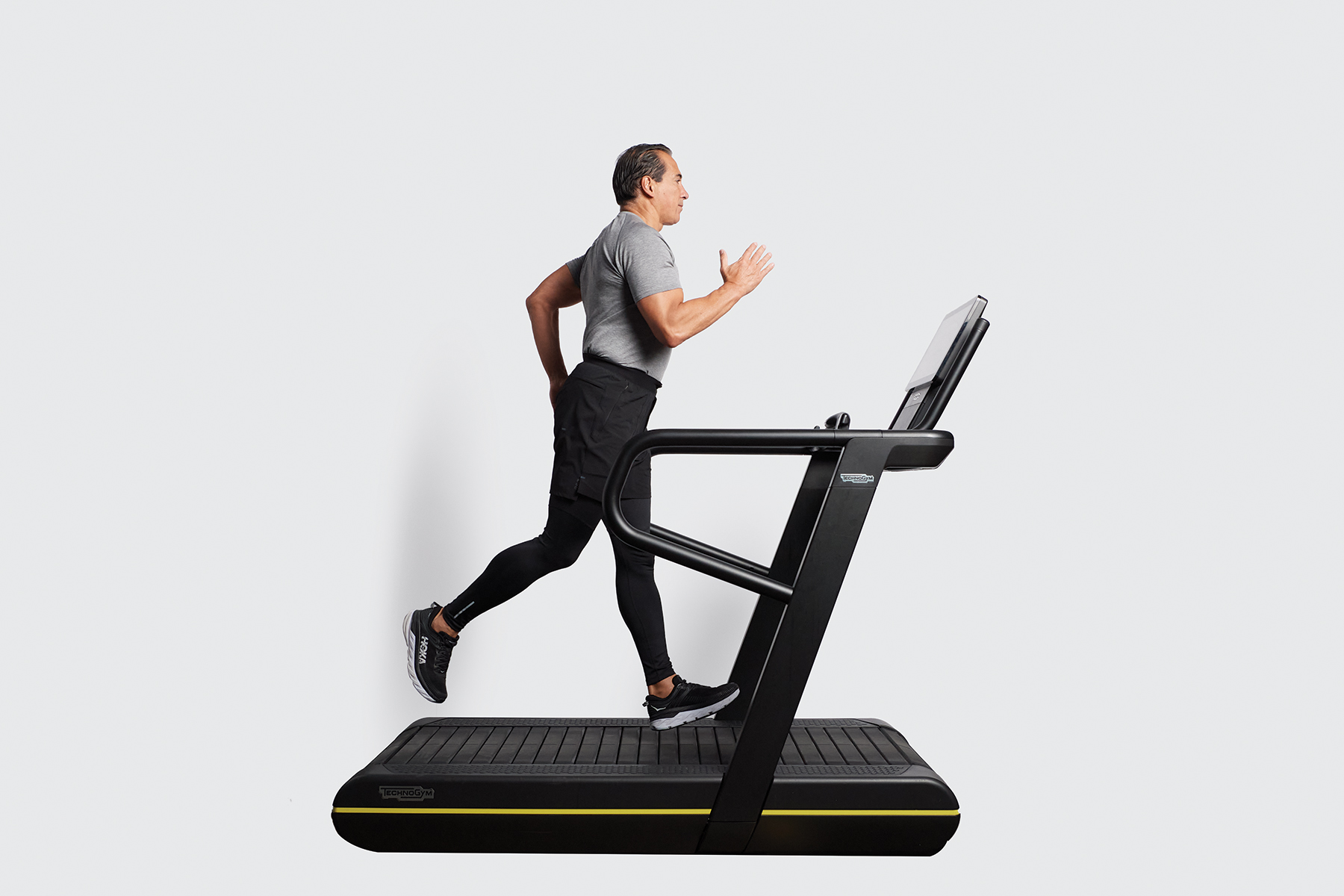
- Jog at an easy pace to gently warm your body up and prepare your mind for a challenging workout.
“Base” Jog: 3 minutes
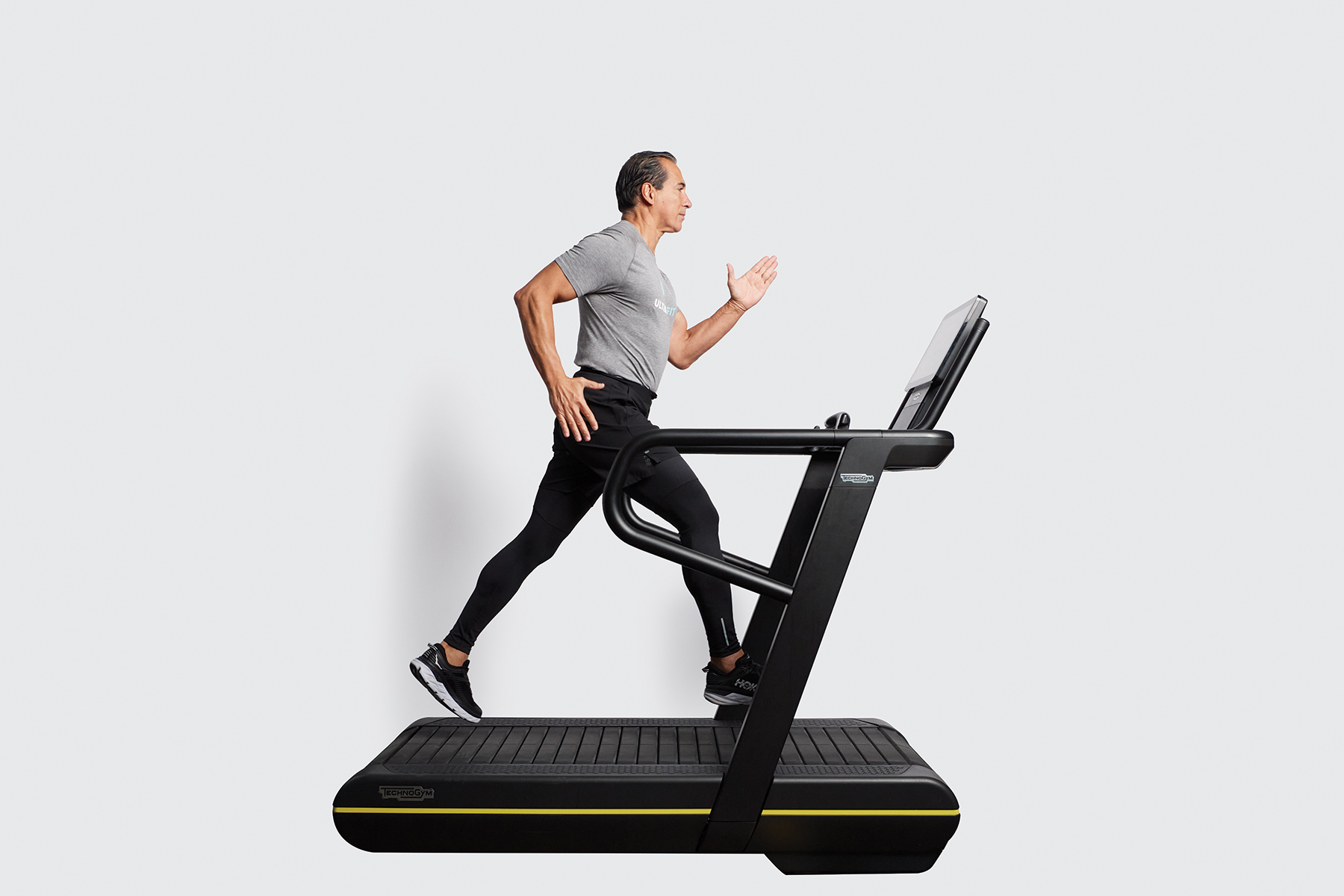
- Aim for 60 percent effort. You’re still prepping you body — this is not a sprint or even a run yet.
Stability Ball Ab Roll
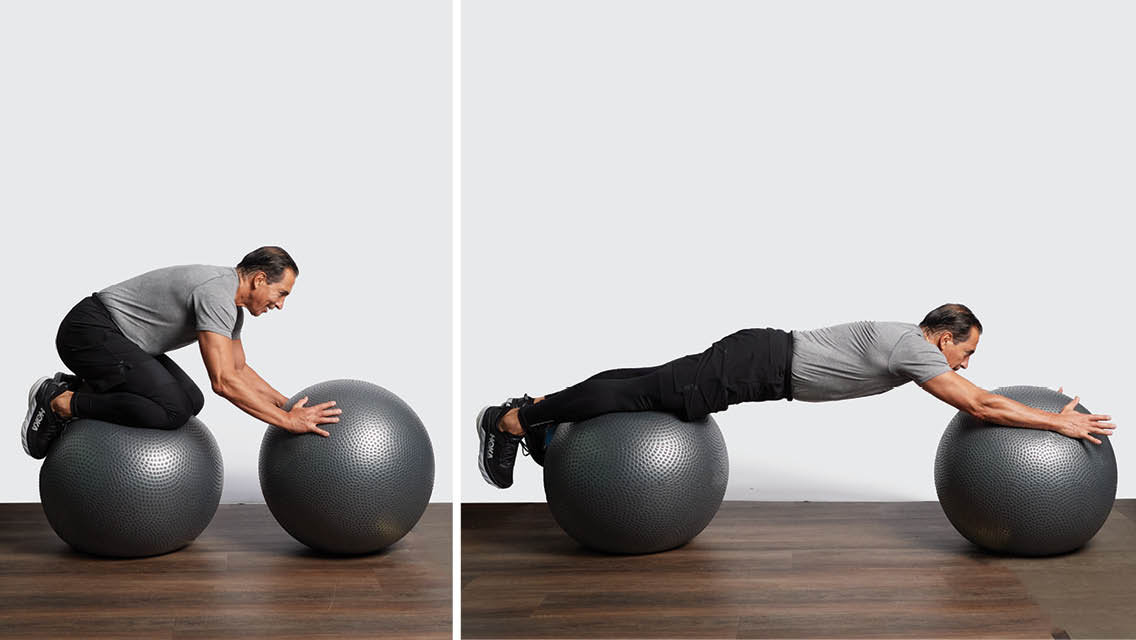
Repeat for a total of 10 repetitions.
Full Instructions
- Begin by balancing your body between two stability balls. Kneel on one ball, sitting your weight back on your heels, and plant your palms firmly on the other ball with your elbows slightly bent.
- With your core engaged, shift your weight forward while rolling the front ball away from the rear ball. Extend your body as far as you can with control, maintaining core engagement.
- Work toward fully extending your hips and shoulders so your body forms a straight line from feet to hands. At this full range, your shins and forearms will be supported by the balls.
- Once you reach the end of your range, press your hands and forearms into the front ball to roll back to your starting position.
Make it easier: Instead of using two stability balls, begin in a high kneeling position on the floor with one stability ball in front of you. Clasp your hands and press them into the ball. Maintaining core engagement, press your hands into the ball and roll it out in front of you until your forearms are on the ball and your body is at a 45 degree angle. Press into the ball with your forearms to roll back into the starting position.
BOSU Squat Hold With Resistance-Band Row
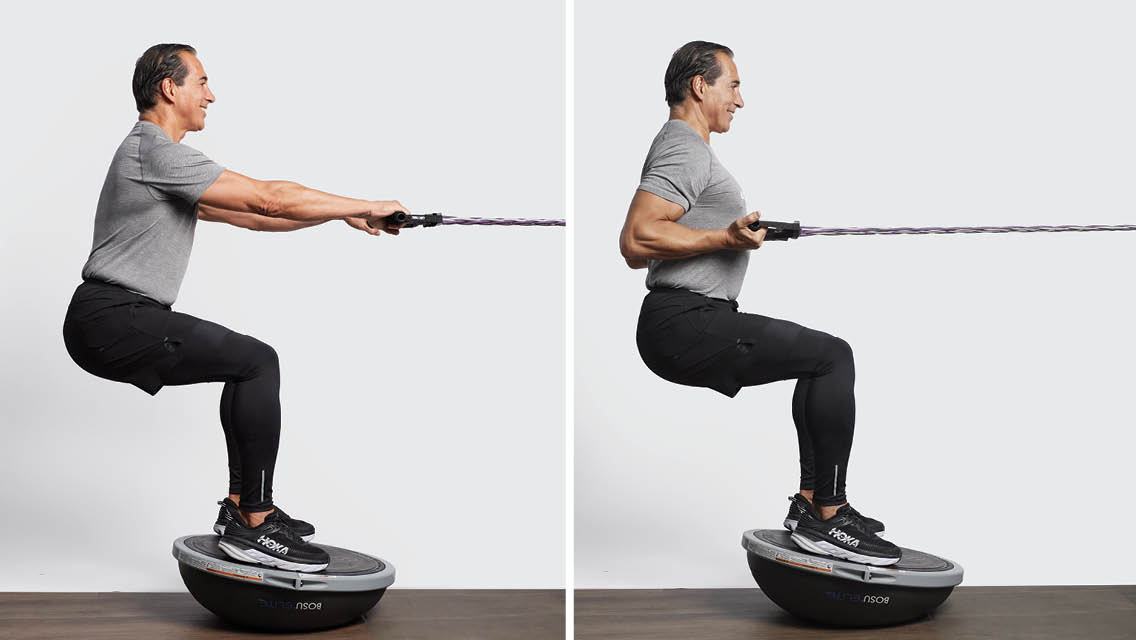
Repeat for a total of 20 repetitions.
Full Instructions
- To set up, anchor a handled resistance band at about face-height. Step back until there is tension on the band and position a BOSU trainer, flat side up, at this spot.
- Grasping one handle in each hand, step up onto the BOSU trainer with control. Once you have your balance, lower into a squat and hold. In this position, the resistance band should be at chest-height. If it’s not, go ahead and adjust the set-up and resume the squat position.
- Holding the squat, begin the row with your arms extended and palms facing down. Engage your upper back and pull the resistance-band handles in toward your ribs. As you row, rotate your hands until your palms are facing up.
- Still holding the squat, reverse the movement to extend your arms and rotate your hands so your palms are facing down.
Make it easier: Instead of positioning the BOSU trainer with the flat-side up, place it so the flat side is on the floor and squat on the domed side. Simplify this further by removing the BOSU and performing the squat and row while standing flat on the floor.
Run at 70 Percent Effort: 2 minutes
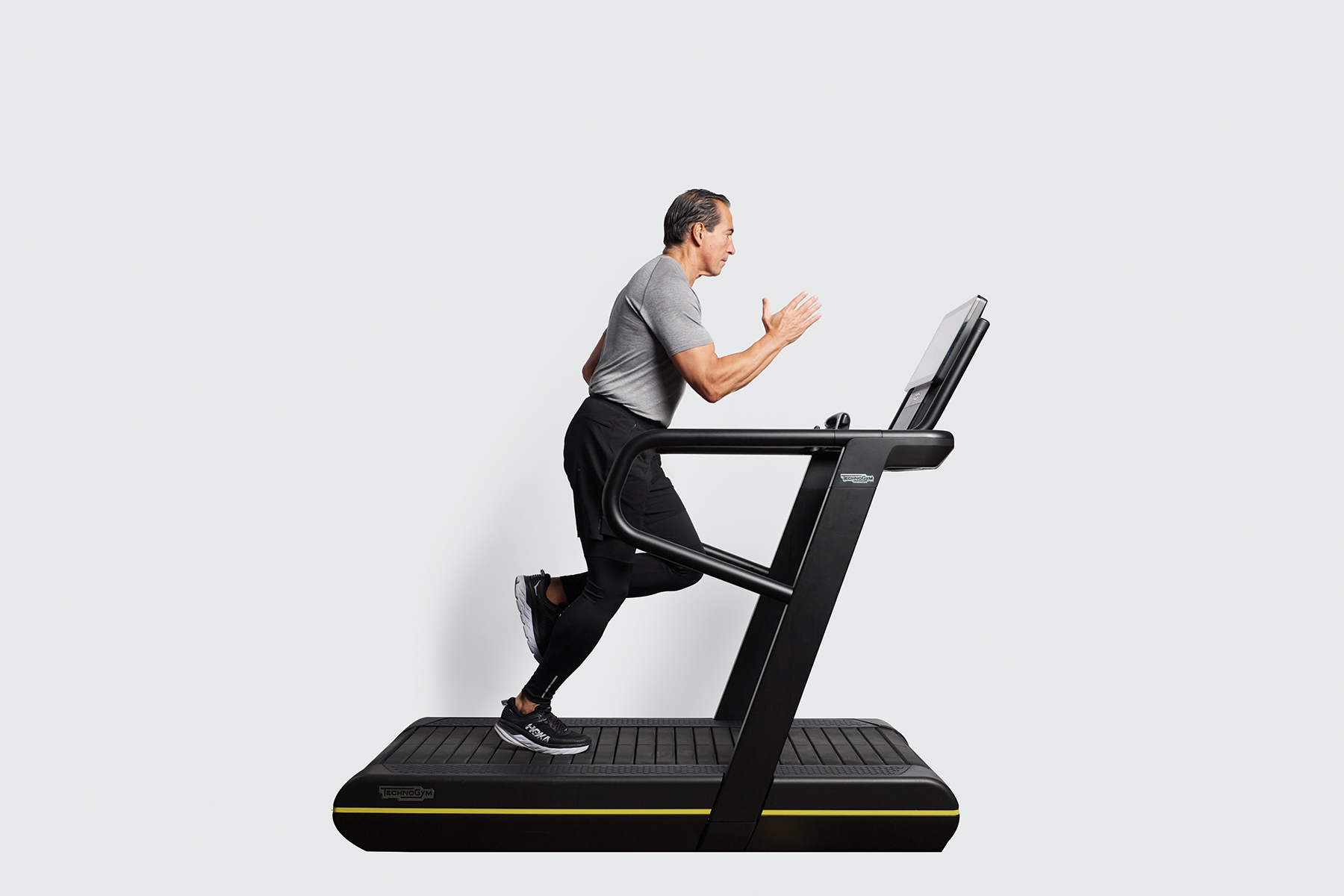
- This is a faster speed than the base run, but not a maximal, all-out effort.
- You want a challenging pace that you can maintain with control and good form for two minutes.
BOSU Overhead Press
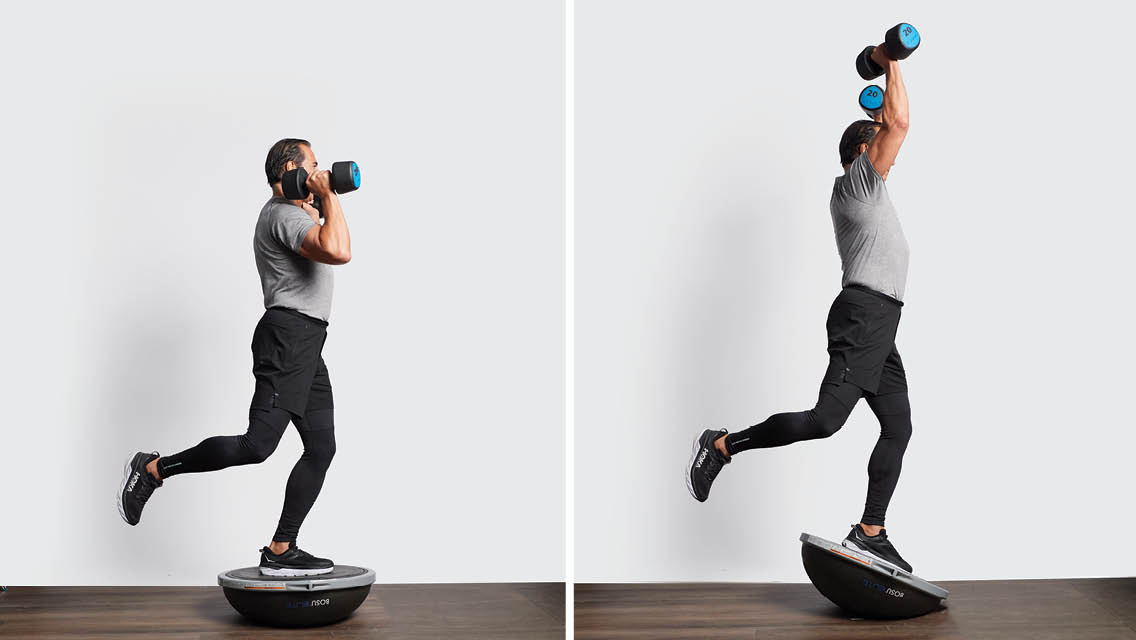
Repeat for 10 repetitions. Then switch sides to balance on the opposite foot and perform another 10 repetitions.
Full Instructions
- Position a BOSU trainer with the flat side facing up. Grasping one medium-weight dumbbell in each hand, place your left foot onto the center of the BOSU and step up with control. Holding the opposite (right) leg aloft behind you, raise the dumbbells up to shoulder height.
- While standing on one foot and keeping your core engaged, press the dumbbells straight overhead.
- Return the weights to shoulder height without replacing your raised foot on the BOSU.
Make it easier: Instead of balancing on one foot at a time, perform all 20 presses while standing with both feet on the flat side of the BOSU. Alternatively, take away the BOSU and perform single-leg overhead presses while balancing on the floor.
BOSU Pushup

Repeat for five repetitions. Then, switch sides to balance on the opposite foot and perform another five repetitions.
Full Instructions
- To set up, position a BOSU trainer, flat side up, a few feet away from a stability ball.
- Grasp the sides of the stability ball with your hands and step your feet up onto the BOSU. Engage your abs to stabilize in this elevated plank position.
- Then, raise one foot so you are in a single-leg plank with your hands on the stability ball and the balls of one foot on the BOSU.
- With control and while maintaining a straight back, engage your upper back and bend your elbows until they form 90-degree angles.
- Reverse the movement to push up into the plank position.
Make it easier: Instead of balancing on one foot at a time, perform all 10 reps with both feet balanced on the stability ball. Alternatively, take away the stability ball and perform pushups with your hands balancing on the BOSU.
BOSU Heisman

Repeat for 10 repetitions. Then, switch sides to balance on the opposite foot and perform another 10 repetitions.
Full Instructions
- Position a BOSU trainer with the flat side facing up. Place your right foot onto the center of the BOSU and step up with control, maintaining a slight bend in the standing-side knee.
- Pull your left (raised) knee in toward your chest. Simultaneously bring your right arm forward, elbow bent, and extend your left arm back for balance. Your left knee should nearly meet the bent elbow of your right arm.
- Maintaining your balance on your right foot, extend your left leg behind you. Simultaneously extend your left arm forward so it is straight in front of you and extend your right arm straight back.
- Reverse the movement to draw arms and knee back in.
Make it easier: Practice this exercise without the BOSU, balancing with one foot on the floor, to get a feel for the movement pattern.
Sprint at 80 Percent Effort: 45 Seconds
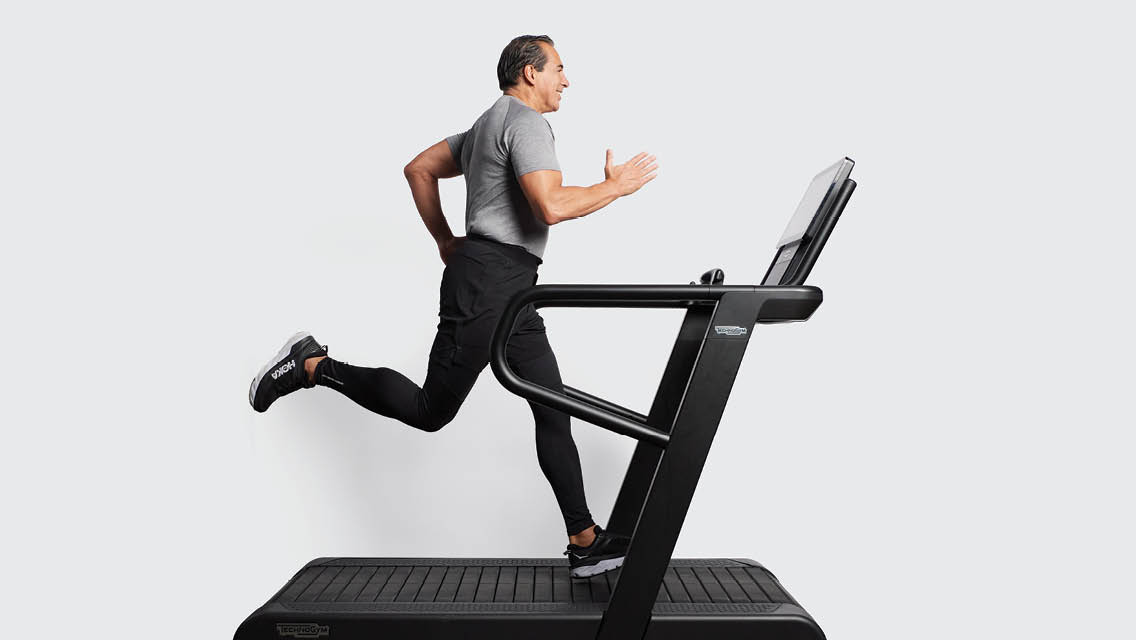
- Consider this the max effort you can hold with good form for 45 seconds.
BOSU Biceps Curl
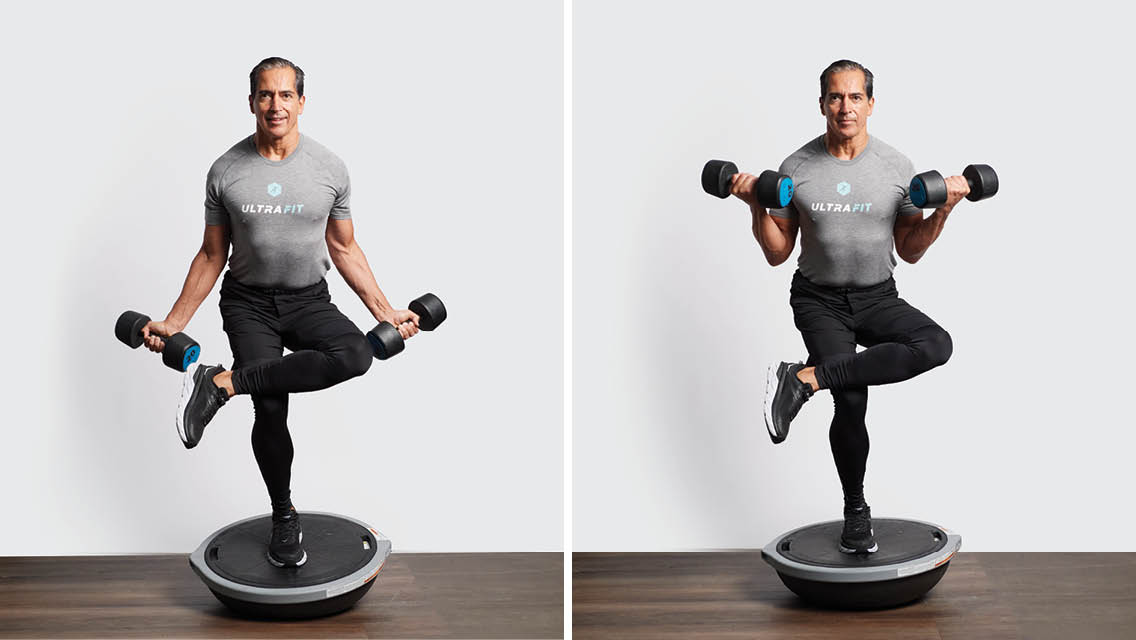
Repeat for 10 repetitions. Then, switch sides to balance on the opposite foot and perform another 10 repetitions.
Full Instructions
- Position a BOSU trainer with the flat side facing up. Grasping one lighter-weight dumbbell in each hand, place your right foot onto the center of the BOSU and step up with control, maintaining a slight bend in the standing-side knee.
- Raise your left leg and cross it over the right so your left ankle rests on your lower left thigh, just above the knee. Lower your hips slightly to sink into this figure-four squat.
- Holding the figure-four position, extend your arms at your sides with palms facing forward. Keeping your upper arms close to your torso, bend your elbows to curl the dumbbells toward your shoulders.
- Reverse the movement to extend the elbows and lower the dumbbells to your sides.
Make it easier: Instead of balancing on one foot at a time, perform all 20 reps with both feet balanced on the BOSU. Alternatively, take away the BOSU and perform biceps curls while balancing on one foot at a time on the floor.
Sprint at 90 Percent Effort: 30 seconds
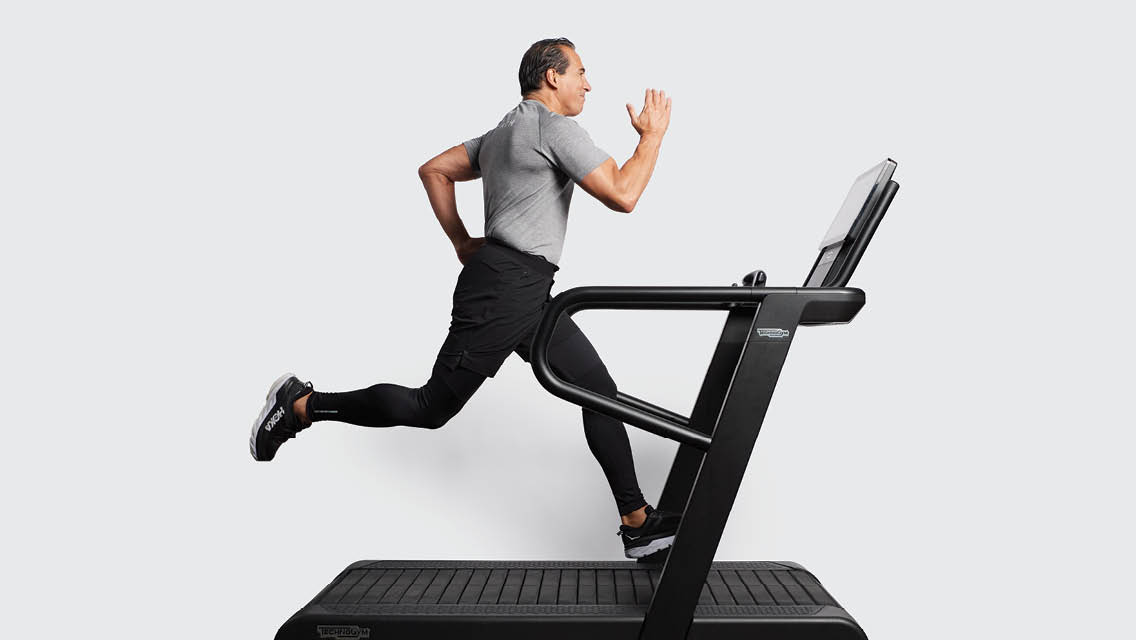
- Slightly faster than 80 percent, this is the max effort you can maintain for 30 seconds.
Stability Ball Figure Eight With ViPR
Note: When performing this advanced move, be sure to have a spotter nearby.
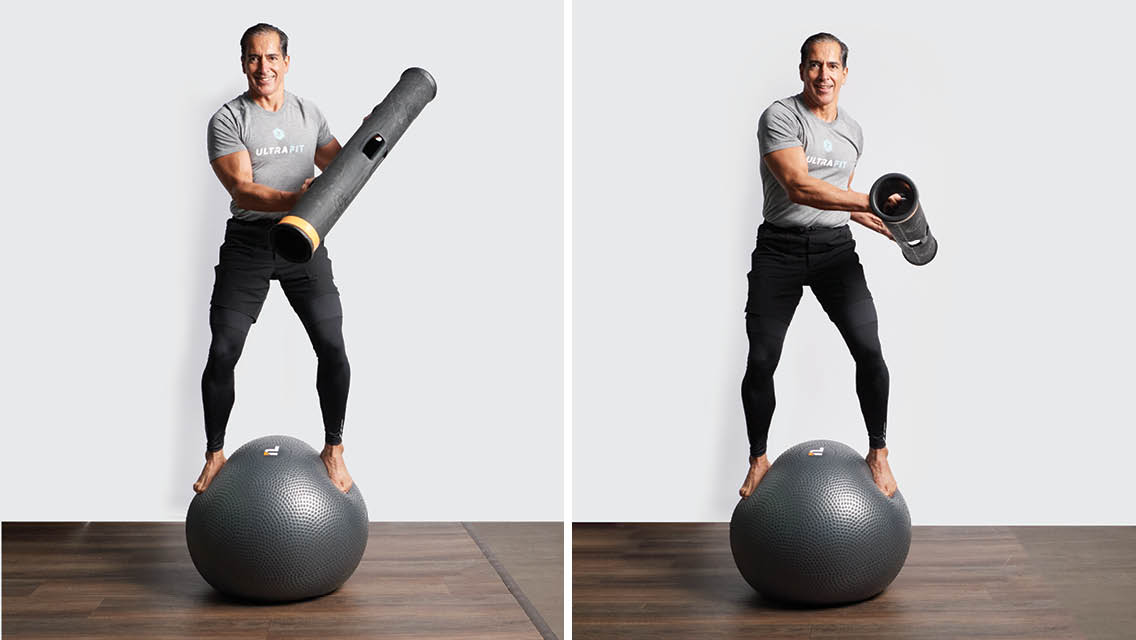
Repeat to perform 20 repetitions.
Full Instructions
- To set up, position a stability ball in a clear area and have a ViPR tube on hand. Assume a standing position on top of the stability ball and grasp the ViPR handles with both hands using a neutral (palms facing together) grip.
- Once you have your balance, begin to move the ViPR, arcing it side-to-side to draw figure-eights with your hands. A visual that may help is to imagine that the ViPR tube is a paddle and you are gently paddling side to side while maintaining your balance. One end will drop down behind your left hip then arc upward and back toward the middle, pushing the opposite end to drop down behind your right hip before arcing upward and back to the middle.
Make it easier: Instead of standing on a stability ball, stand on the domed side of a BOSU trainer (flat side on the floor).
Final Sprint at 100 Percent Effort: 15 seconds
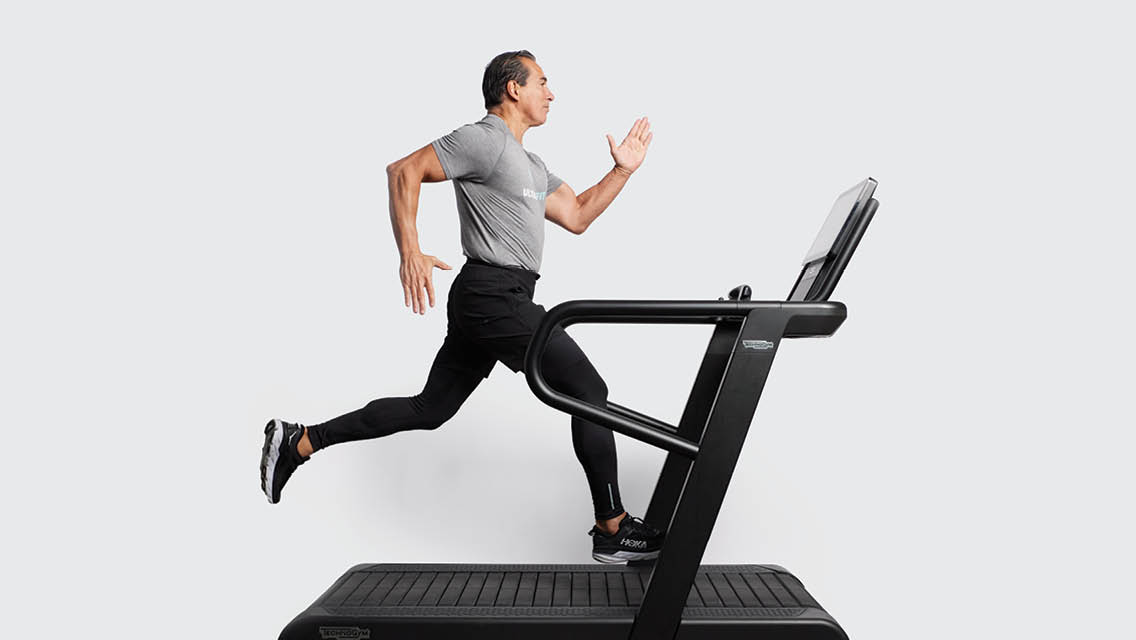
- This is your all-out max effort. Finish the workout strong with a 15-second push.
Easy Cool-Down Jog or Walk: 5 to 10 minutes
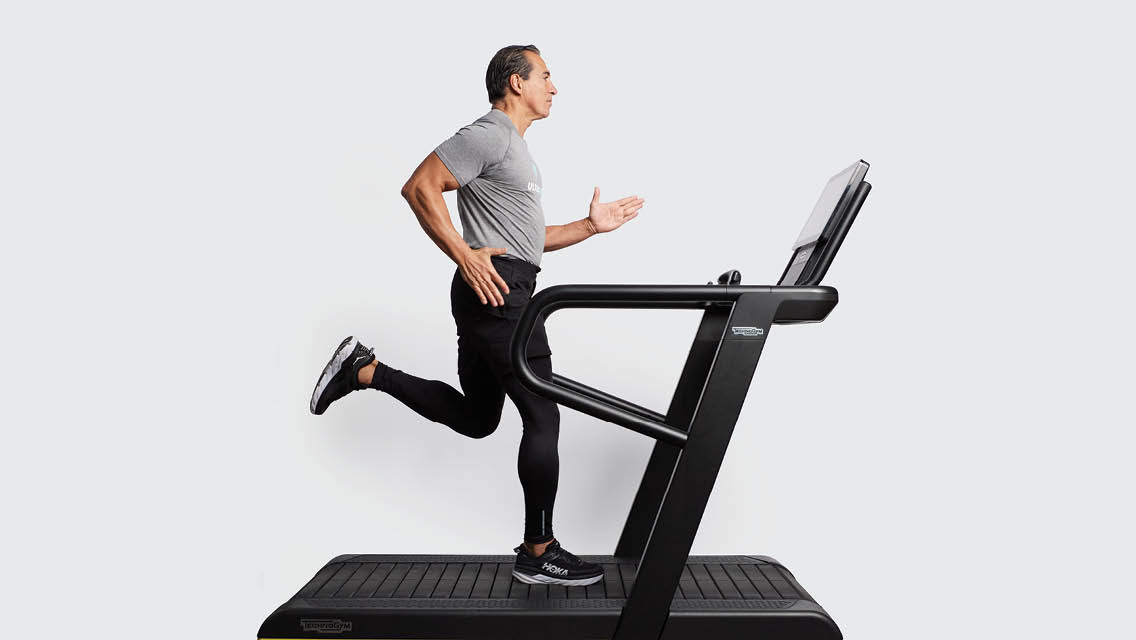
- Use this time to lower your heart rate, catch your breath, release tension, and begin the recovery process. (Follow it up with a four-stretch cool-down routine at “4 Cool Down Exercises“.)





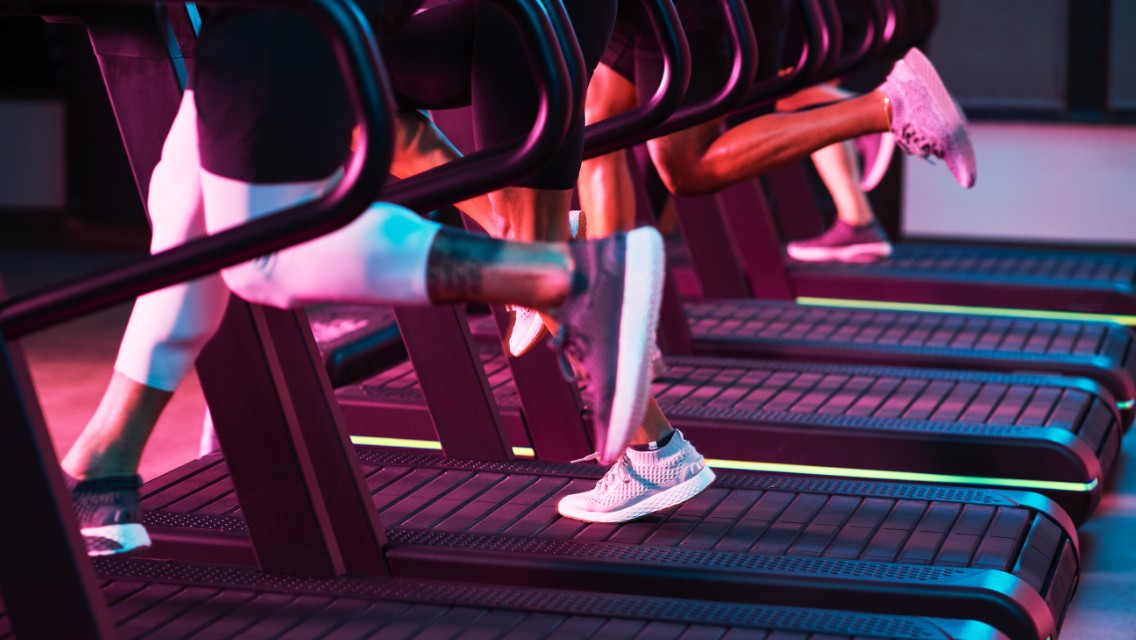
This Post Has 0 Comments